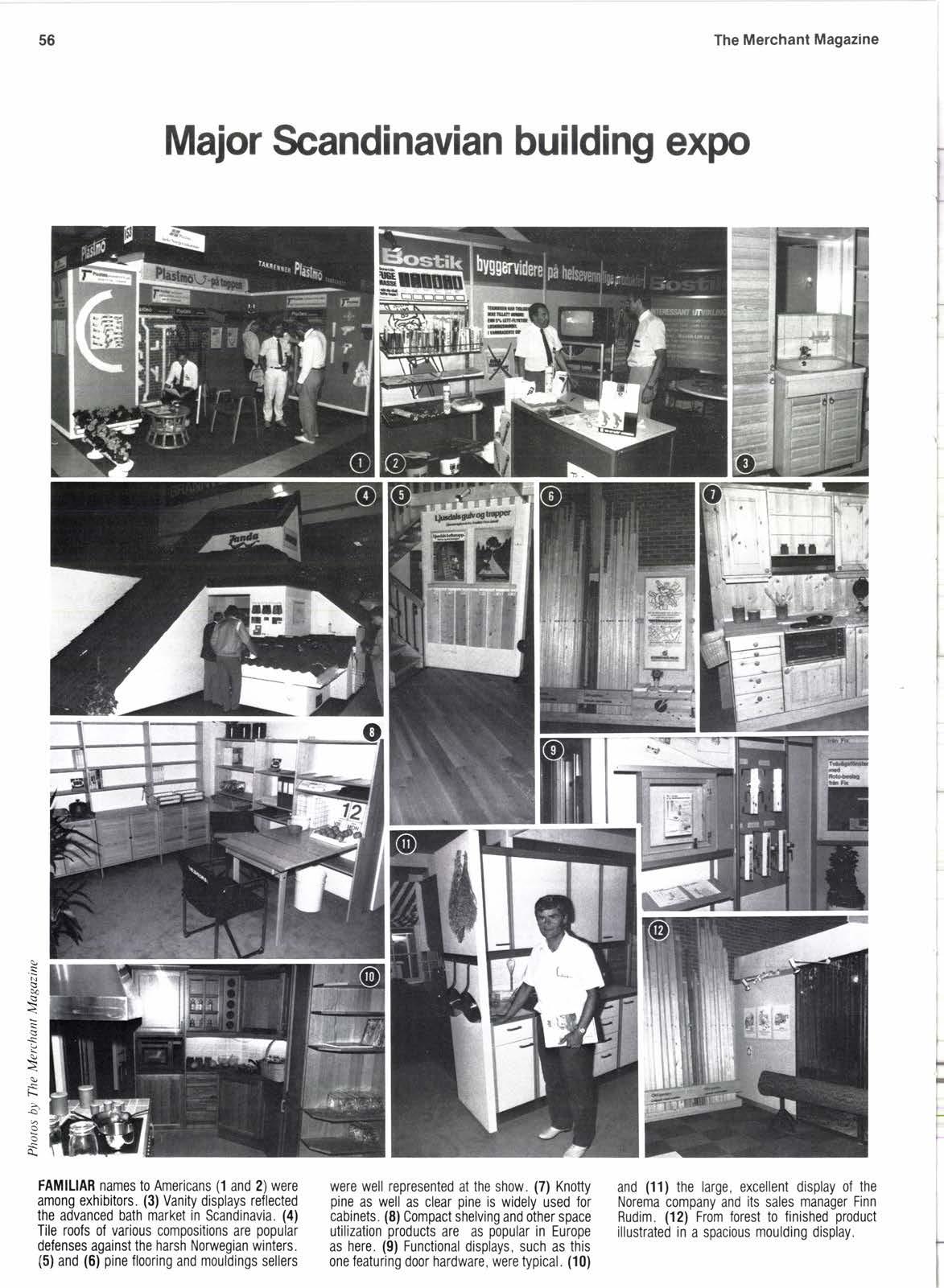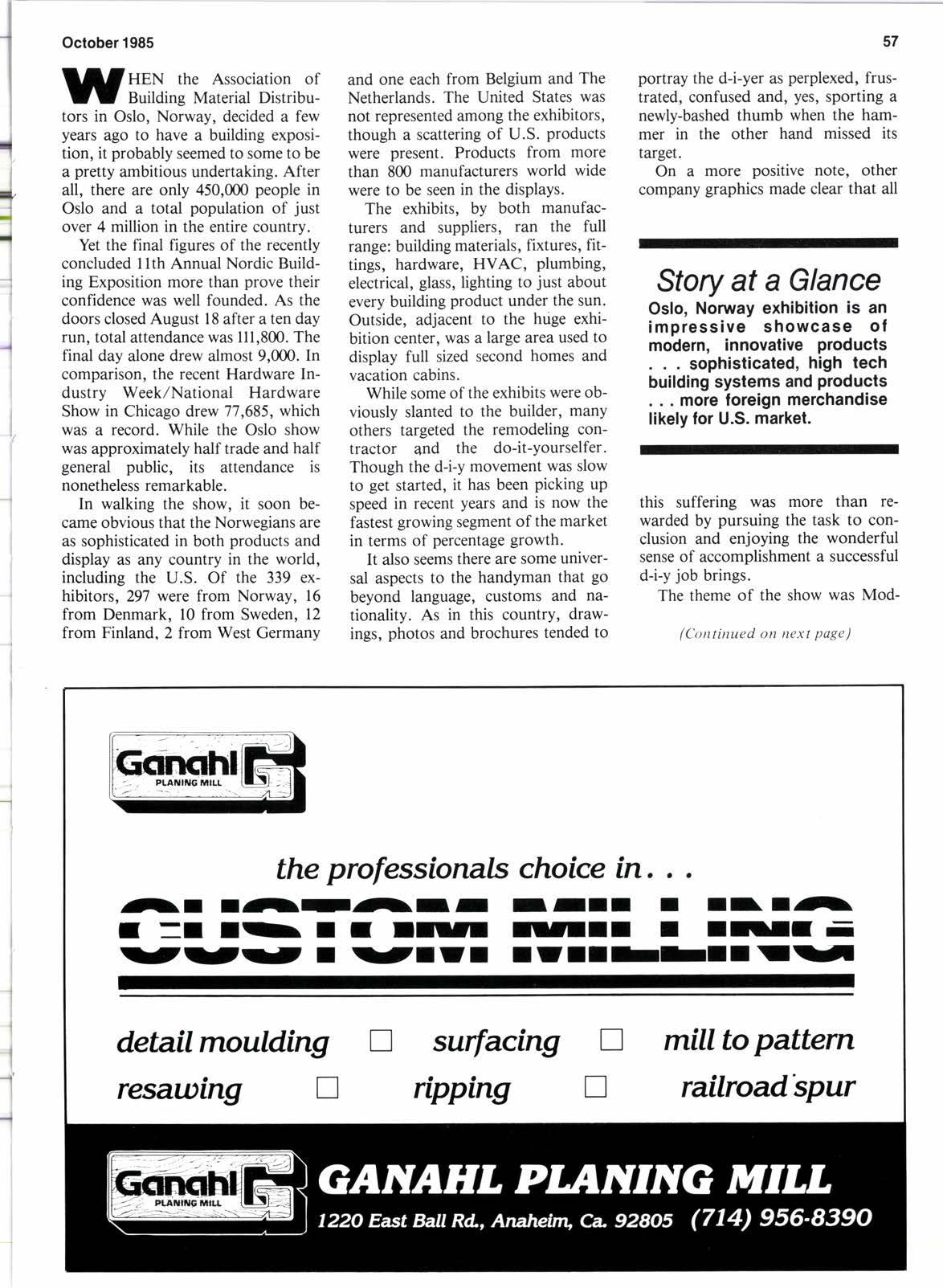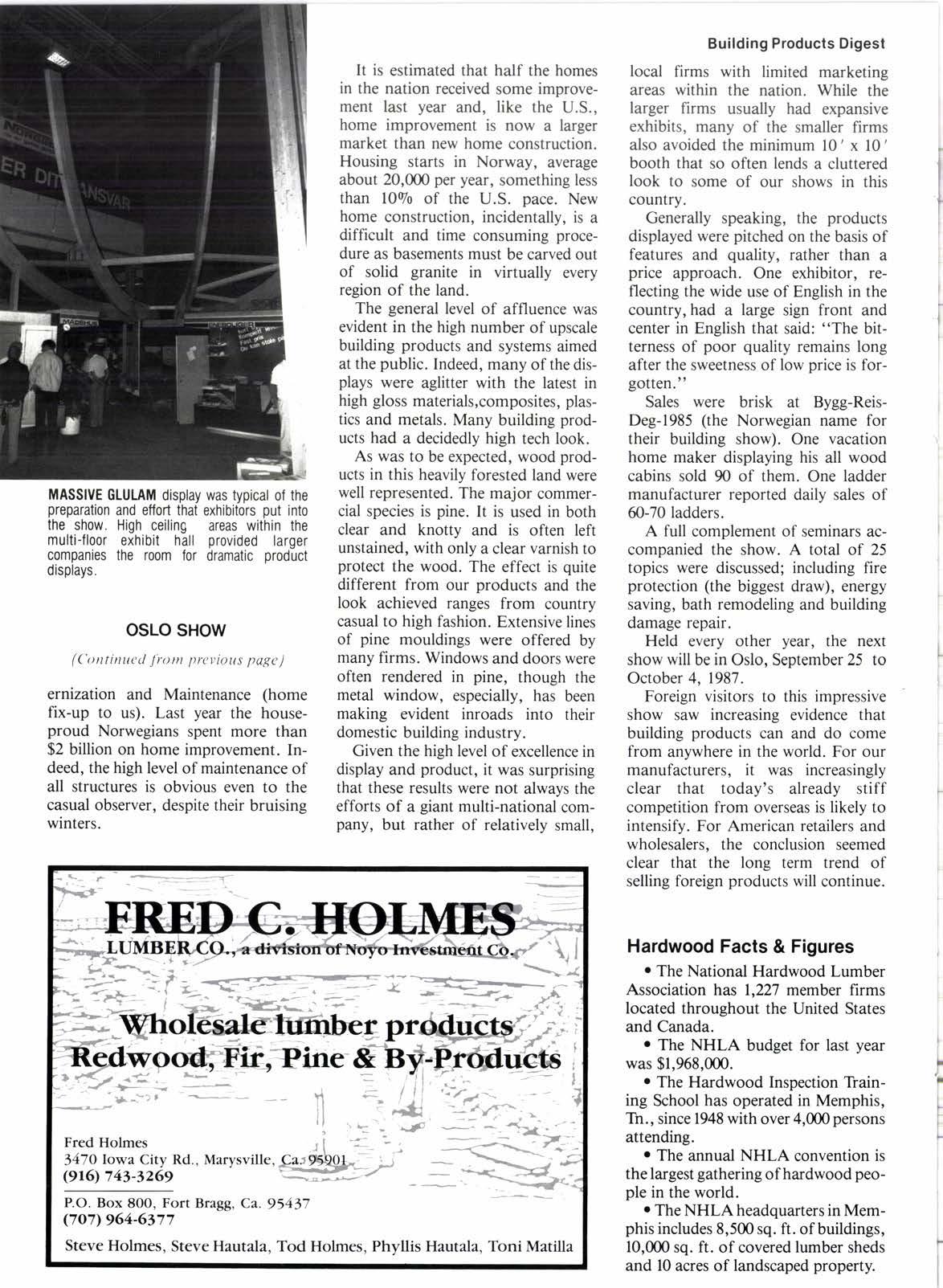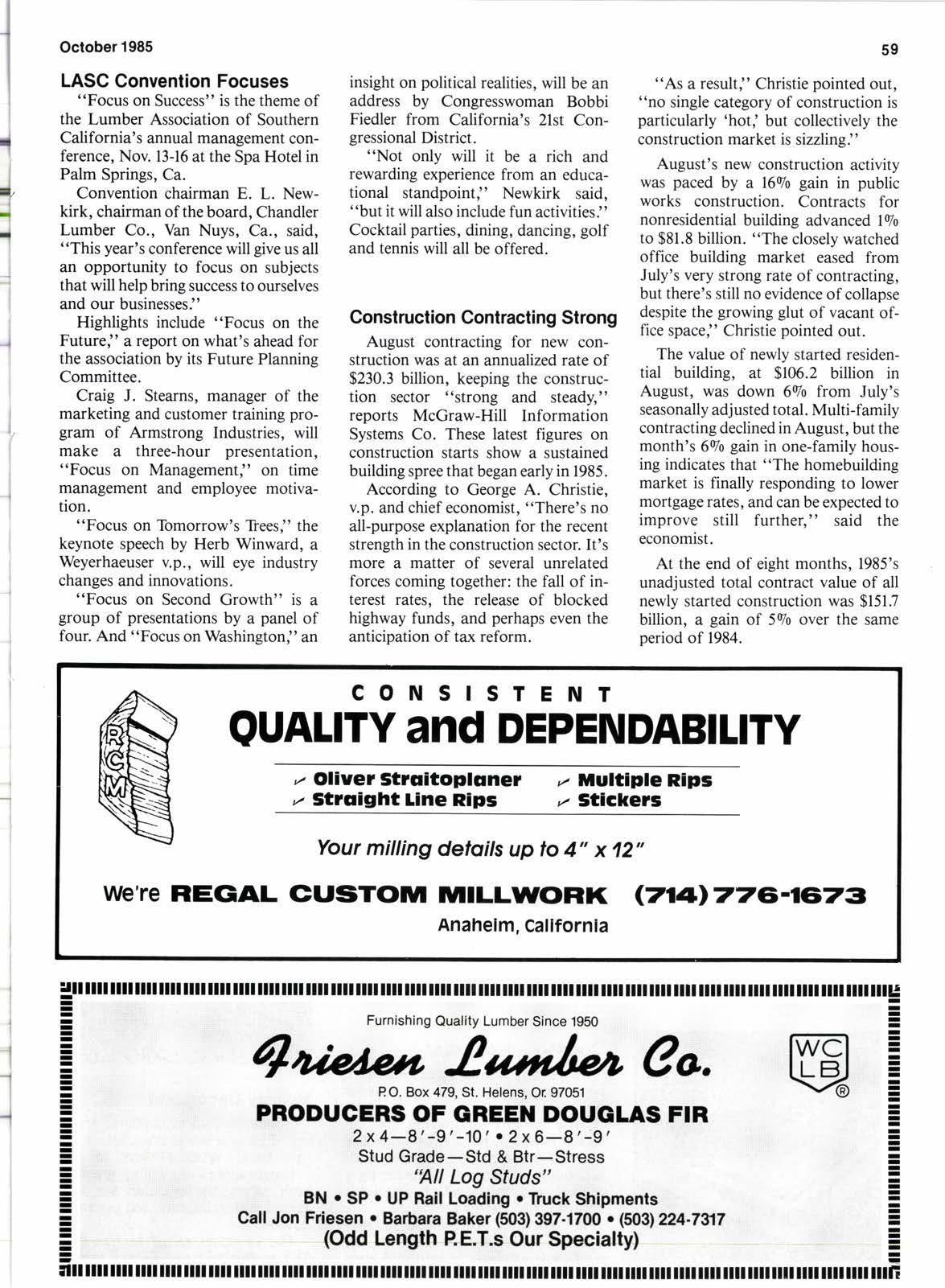
6 minute read
MaiorScandinavian building expo
HENthe Association of Building Material Distributors in Oslo, Norway, decided a few years ago to have a building exposition, it probably seemed to some to be a pretty ambitious undertaking. After all, there are only 450,000 people in Oslo and a total population of just over 4 million in the entire country.
Yet the final figures of the recently concluded I lth Annual Nordic Building Exposition more than prove their confidence was well founded. As the doors closed August l8 after a ten day run, total attendance was 111,800. The final day alone drew almost 9,000. In comparison, the recent Hardware Industry Week/National Hardware Show in Chicago drew 77,685, which was a record. While the Oslo show was approximately half trade and half general public, its attendance is nonetheless remarkable.
In walking the show, it soon became obvious that the Norwegians are as sophisticated in both products and display as any country in the world, including the U.S. Of the 339 exhibitors, 297 were from Norway, 16 from Denmark, l0 from Sweden, 12 from Finland, 2 from West Germany and one each from Belgium and The Netherlands. The United States was not represented among the exhibitors, though a scattering of U.S. products were present. Products from more than 800 manufacturers world wide were to be seen in the displays.
The exhibits, by both manufacturers and suppliers, ran the full range: building materials, fixtures, fittings, hardware, HVAC, plumbing, electrical, glass, lighting to just about every building product under the sun. Outside, adjacent to the hdge exhibition center, was a large area used to display full sized second homes and vacation cabins.
While some of the exhibits were obviously slanted to the builder, many others targeted the remodeling contractor and the do-it-yourselfer. Though the d-i-y movement was slow to get started, it has been picking up speed in recent years and is now the fastest growing segment of the market in terms of percentage growth.
It also seems there are some universal aspects to the handyman that go beyond language, customs and nationality. As in this country, drawings, photos and brochures tended to portray the d-i-yer as perplexed, frustrated, confused and, yes, sporting a newly-bashed thumb when the hammer in the other hand missed its target.
On a more positive note, other company graphics made clear that all

Story at a Glance
Oslo, Nonray exhibition is an impressive showcase of modern, innovative products . . sophisticated, high tech building systems and products more foreign merchandise likely lor U.S. markel.
this suffering was more than rewarded by pursuing the task to conclusion and enjoying the wonderful sense of accomplishment a successful d-i-y job brings.
The theme of the show was Mod-
(Continued on next page)
oslo sHow
(Continuetl Jrcn prcviotts page) ernization and Maintenance (home fix-up to us). Last year the houseproud Norwegians spent more than $2 billion on home improvement. Indeed, the high level of maintenance of all structures is obvious even to the casual observer, despite their bruising winters.
It is estimated that half the homes in the nation received some improvement last year and, like the U.S., home improvement is now a larger market than new home construction. Housing starts in Norway, average about 20,000 per year, something less than l09o of the U.S. pace. New home construction, incidentally, is a difficult and time consuming procedure as basements must be carved out of solid granite in virtually every region of the land.
The general level of affluence was evident in the high number of upscale building products and systems aimed at the public. Indeed, many of the displays were aglitter with the latest in high gloss materials,composites, plastics and metals. Many building products had a decidedly high tech look.
As was to be expected, wood products in this heavily forested land were well represented. The major commercial species is pine. It is used in both clear and knotty and is often left unstained, with only a clear varnish to protect the wood. The effect is quite different from our products and the look achieved ranges from country casual to high fashion. Extensive lines of pine mouldings were offered by many firms. Windows and doors were often rendered in pine, though the metal window, especially, has been making evident inroads into their domestic building industry.
Given the high level of excellence in display and product, it was surprising that these results were not always the efforts of a giant multi-national company, but rather of relatively small, local firms with limited marketing areas within the nation. While the larger firms usually had expansive exhibits, many of the smaller firms also avoided the minimum l0' x l0' booth that so often lends a cluttered look to some of our shows in this country.
Generally speaking, the products displayed were pitched on the basis of features and quality, rather than a price approach. One exhibitor, reflecting the wide use of English in the country, had a large sign front and center in English that said: "The bitterness of poor quality remains long after the sweetness of low price is forgotten."
Sales were brisk at Bygg-ReisDeg-1985 (the Norwegian name for their building show). One vacation home maker displaying his all wood cabins sold 90 of them. One ladder manufacturer reported daily sales of 60-70 ladders.

A full complement of seminars accompanied the show. A total of 25 topics were discussed; including fire protection (the biggest draw), energy saving, bath remodeling and building damage repair.
Held every other year, the next show will be in Oslo, September 25 to October 4, 1987.
Foreign visitors to this impressive show saw increasing evidence that building products can and do come from anywhere in the world. For our manufacturers, it was increasingly clear that today's already stiff competition from overseas is likely to intensify. For American retailers and wholesalers, the conclusion seemed clear that the long term trend of selling foreign products will continue.
Hardwood Facts & Figures
o The National Hardwood Lumber Association has 1,221 member firms located throughout the United States and Canada.
o The NHLA budget for last year was $1,968,000.
o The Hardwood Inspection Tiaining School has operated in Memphis, Th., since 1948 with over 4,000 persons attending.
o The annual NHLA convention is the largest gathering ofhardwood people in the world.
o The NHLA headquarters in Memphis includes 8,500 sq. ft. of buildings, 10,000 sq. ft. of covered lumber sheds and l0 acres of landscaped property.
LASC Convention Focuses
"Focus on Success" is the theme of the Lumber Association of Southern California's annual management conference, Nov. 13-16 at the Spa Hotel in Palm Springs, Ca.
Convention chairman E. L. Newkirk, chairman of the board, Chandler Lumber Co., Van Nuys, Ca., said, "This year's conference will give us all an opportunity to focus on subjects that will help bring success to ourselves and our businesses."
Highlights include "Focus on the Future," a report on what's ahead for the association by its Future Planning Committee.
Craig J. Stearns, manager of the marketing and customer training program of Armstrong Industries, will make a three-hour presentation, "Focus on Management," on time management and employee motivation.
"Focus on Tomorrow's Tlees." the keynote speech by Herb Winward, a Weyerhaeuser v.p., will eye industry changes and innovations.
"Focus on Second Growth" is a group of presentations by a panel of four. And "Focus on Washington," an insight on political realities, will be an address by Congresswoman Bobbi Fiedler from California's 2lst Congressional District.
"Not only will it be a rich and rewarding experience from an educational standpoint," Newkirk said, "but it will also include fun activities." Cocktail parties, dining, dancing, golf and tennis will all be offered.
Construction Contracting Strong
August contracting for new construction was at an annualized rate of $230.3 billion, keeping the construction sector "strong and steady," reports McGraw-Hill Information Systems Co. These latest figures on construction starts show a sustained building spree that began early in 1985.
According to George A. Christie, v.p. and chief economist, "There's no all-purpose explanation for the recent strength in the construction sector. It's more a matter of several unrelated forces coming together: the fall of interest rates, the release of blocked highway funds, and perhaps even the anticipation of tax reform.
"As a result," Christie pointed out, "no single category of construction is particularly 'hot,' but collectively the construction market is sizzling."
August's new construction activity was paced by a l6t/o gain in public works construction. Contracts for nonresidential building advanced l9o to $81.8 billion. "The closely watched office building market eased from July's very strong rate of contracting, but there's still no evidence of collapse despite the growing glut of vacant office space," Christie pointed out.
The value of newly started residential building, at $106.2 billion in August, was down 690 from July's seasonally adjusted total. Multi-family contracting declined in August, but the month's 6Vo gain in one-family housing indicates that "The homebuilding market is finally responding to lower mortgage rates, and can be expected to improve still further," said the economist.
At the end of eight months, 1985's unadjusted total contract value of all newly started construction was $151J billion, a gain of 590 over the same period of 1984.











